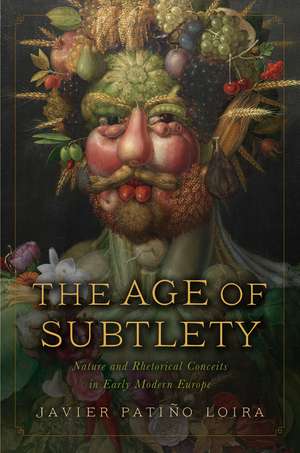The Age of Subtlety: Nature and Rhetorical Conceits in Early Modern Europe: The Early Modern Exchange
Autor Javier Patiño Loiraen Limba Engleză Paperback – 14 iun 2024
Preț: 362.12 lei
Preț vechi: 447.07 lei
-19% Nou
Puncte Express: 543
Preț estimativ în valută:
69.29€ • 72.53$ • 57.67£
69.29€ • 72.53$ • 57.67£
Carte disponibilă
Livrare economică 10-24 martie
Livrare express 22-28 februarie pentru 31.37 lei
Preluare comenzi: 021 569.72.76
Specificații
ISBN-13: 9781644533444
ISBN-10: 1644533448
Pagini: 326
Ilustrații: 3 color and 12 B-W images
Dimensiuni: 156 x 235 x 23 mm
Greutate: 0.48 kg
Editura: University of Delaware Press
Colecția University of Delaware Press
Seria The Early Modern Exchange
ISBN-10: 1644533448
Pagini: 326
Ilustrații: 3 color and 12 B-W images
Dimensiuni: 156 x 235 x 23 mm
Greutate: 0.48 kg
Editura: University of Delaware Press
Colecția University of Delaware Press
Seria The Early Modern Exchange
Notă biografică
JAVIER PATIÑO LOIRA is assistant professor of Spanish at UCLA. He is the author of numerous articles and book chapters on early modern Italian and Spanish rhetorical and poetic theory and the formation of libraries, as well as ideas on education and translation.
Cuprins
Acknowledgments
Introduction: The Early Modern Culture of Ingenuity
Part I Comets
1 Poetry’s Comets: On Novelty and Artifice
2 Gossip Made of Glass: On Artifice and Deceit
Part II Fireflies
3 At Small Scale: Multiplicity, Variety, and Play
4 The Life of Conceits: Juggling, Magic, and Alchemy
Epilogue
Notes
Bibliography
Index
Introduction: The Early Modern Culture of Ingenuity
Part I Comets
1 Poetry’s Comets: On Novelty and Artifice
2 Gossip Made of Glass: On Artifice and Deceit
Part II Fireflies
3 At Small Scale: Multiplicity, Variety, and Play
4 The Life of Conceits: Juggling, Magic, and Alchemy
Epilogue
Notes
Bibliography
Index
Descriere
The Age of Subtlety is the first book-length study to examine the seventeenth-century craze for rhetorical conceits in connection with scientific and technological debates. Focusing on Italy and Spain, it argues that these intricate and challenging metaphors became embodiments of a competition between natural and human ingenuity, as well as sites to reflect on the consequences of telescopic and microscopic vision, the boundaries between natural and artificial, and the generation of life.
















